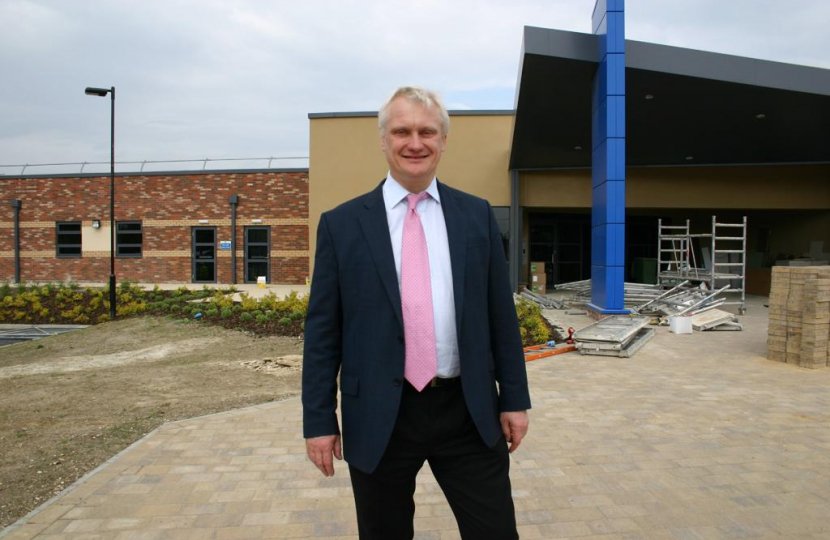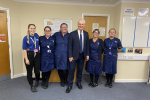- East Riding Community Hospital and Withernsea Community Hospital to be designated Community Diagnostic Centres, delivering more life-saving checks, tests and scans and speed up diagnoses for local patients
- These hospitals are two of 19 across England which have been designated as such.
- This is a part of a package of measures designed to tackle Covid backlog across the country.
Graham Stuart MP has welcomed the announcement of two new Community Diagnostic Centres in Beverley and Holderness.
In order to tackle the Covid backlog, and give patients access to treatment and lifesaving diagnostic tests in their communities, Health Secretary Steve Barclay has announced that Beverley and Withernsea will be two of 19 new ‘one stop shops’ for tests, checks and scans across England.
The NHS has made progress in tackling the Covid backlogs, virtually eliminating waits of over two years for treatment – the first target in the Elective Recovery Plan – and reducing the number of people waiting 18 months for treatment by almost 60% in one year.
The taskforce will help deliver on the remaining targets, including eliminating 18-month waits by April 2023 and waits of longer than a year by March 2025.
The launch comes as the Health and Social Care Secretary announced the locations of 19 new Community Diagnostic Centres (CDCs) across the country which will help more people to easily access life-saving checks, tests and scans – and follows record investment into health and social care with the Autumn Statement committing up to an additional £8 billion for health and social care in 2024/25.
Commenting, Graham Stuart, MP for Beverley and Holderness said:
“I’m delighted that Withernsea and Beverley are playing our part in tackling the Covid backlogs – and our community will benefit enormously from these new Community Diagnostic Centres.
“People across Beverley and Holderness deserve the shortest possible waiting times for lifesaving treatment – and these new centres in Withernsea and Beverley will do just that.”
Commenting, Health and Social Care Secretary Steve Barclay said:
“The NHS is facing an unprecedented challenge to tackle Covid backlogs.
“Hardworking staff have made strong progress but I want to turbocharge our current plans to bust the backlog and help patients get the treatment they need.
“The taskforce will look at sensible steps to utilise all existing capacity to slash waiting lists while ensuring the NHS always remains free at the point of use.”
The taskforce, which will meet for the first time at Downing Street today, will be chaired by Health Minister Will Quince and made up of academics and experts from the NHS and independent sector to advise the government on ways to turbocharge NHS recovery from the pandemic, reduce waiting times for patients and eliminate waits for routine care of over a year by 2025.
Experts will focus on how the NHS can utilise existing capacity in independent sector to cut the backlog. The independent sector has been used to bolster NHS capacity and ease pressure at critical times for nearly two decades, delivering over 450,000 appointments in October alone, approximately 6% of NHS care. Commissioning of independent sector services by the NHS uses existing budgets and comes at no extra cost to the NHS, delivering value for taxpayer money.
The taskforce will bring together a group of experts to work on a series of recommendations which will be put to the government early next year on how the NHS can better commission the independent sector, supporting the NHS as it pulls out all the stops to tackle the Covid backlogs.
Specialties including ophthalmology and knee and hip replacements have led the way with successful collaboration with the independent sector meaning patients can return to their normal lives faster.
The taskforce will look to improve communication and collaboration between the NHS and independent sector, clearly setting out what theatres, beds and other settings (such as outpatients) are available in the independent sector. Maximising use of all additional capacity will support patients and ensure the NHS always remains free at the point of use.
The new diagnostic centres will be located in the heart of communities across the country including football stadiums and shopping centres offering a range of services including MRI, CT and x-rays, making tests more accessible for patients. They will take the total of approved CDCs to 127, over 80% of the government's intention to open up to 160 CDCs to perform up to nine million additional tests a year by 2025.
91 are already up and running across the country and new data shows the one-stop shops, backed by £2.3 billion in government funding, have delivered over 2.4 million tests, checks and scans since July 2021. These are speeding up access to services for patients and reducing waiting times. In September CDCs delivered 11% of all diagnostic activity, a significant step in achieving our ambition for 40% of diagnoses to take place in CDCs by 2025.



